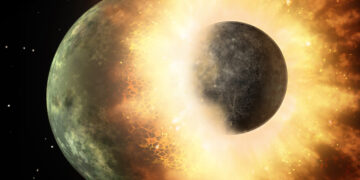Imagine a world where Earth was not yet the familiar blue planet we know today. Around 4.4 billion years ago, our planet was still forming, and an ancient protoplanet named Theia was on a fateful path. The Giant-Impact Hypothesis suggests that Theia, a Mars-sized celestial body, collided with early Earth in a violent cosmic crash that reshaped our planet forever. From the debris of this cataclysmic event, the Moon was born.
The Theory Behind the Impact
The Giant-Impact Hypothesis is the most widely accepted explanation for the Moon’s formation. According to this theory, Theia crashed into Earth, ejecting a vast amount of debris into space. This material eventually coalesced into the Moon under the influence of gravity.
Scientists believe this impact:
- Altered Earth’s rotational dynamics, speeding up its spin.
- Ejected material into space, forming a debris disk around Earth.
- Created the conditions necessary for the Moon to form, making Earth unique among rocky planets.
Why Do Scientists Believe Theia Existed?
There are several compelling reasons why astronomers and planetary scientists support the existence of Theia:
- Earth’s unusually large Moon: Compared to other rocky planets, Earth’s Moon is disproportionately large. Venus and Mercury have no moons, while Mars only has two small, asteroid-like moons. This suggests an unusual formation history.
- The rapid spin of Earth: The impact would have imparted significant energy, explaining why Earth rotates faster than other rocky planets.
- Similarities between Earth and Moon rocks: The Moon’s composition closely resembles Earth’s outer layers, reinforcing the idea that they share a common origin.
The Search for Theia’s Lost Pieces
For years, scientists have wondered: If Theia existed, where did its remains go? Recent research suggests that remnants of Theia may still be buried deep within Earth’s mantle. Seismic studies have revealed two massive structures called Large Low Shear Velocity Provinces (LLSVPs) beneath Africa and the Pacific Ocean.
The Evidence from Mantle Anomalies
These LLSVPs are denser and compositionally different from the surrounding mantle, leading scientists to propose that they could be remnants of Theia. If true, this would provide direct evidence of the ancient impact.
According to a study published in Nature, “The presence of anomalous mantle structures supports the hypothesis that Theia’s remnants were absorbed by Earth rather than being completely ejected into space.”
Lunar Samples and Earth-Moon Connection
The Apollo missions provided critical evidence supporting the Giant-Impact Hypothesis. Between 1969 and 1972, astronauts brought back over 400 kg of lunar material, including rocks and regolith (lunar soil). Analysis of these samples revealed surprising findings:
- Oxygen isotope similarities: Moon rocks contain oxygen isotopes nearly identical to those found on Earth.
- Lack of volatile compounds: Unlike Earth, the Moon lacks elements that evaporate easily, suggesting it was formed from high-energy impact debris.
- High-temperature rock formation: The Moon’s crust shows signs of being created from molten rock, consistent with a massive collision.
How the Apollo Data Changed Our Understanding
Before the Apollo missions, scientists considered multiple theories for the Moon’s formation, including capture theory (the idea that Earth’s gravity captured a wandering moon) and co-formation theory (where Earth and the Moon formed together). However, the similarities between Earth and Moon rocks made these theories less likely.
How Long Did It Take to Form the Moon?
Recent high-resolution simulations suggest that the Moon could have formed much faster than previously thought—possibly within mere hours or days, rather than over years. The simulations showed that a single giant impact could eject enough material into orbit to rapidly form a moon.
Challenges in Proving the Hypothesis
Despite strong evidence, there are still open questions:
- How much of Theia merged with Earth versus being ejected into space?
- What happened to Theia’s core?
- Did Theia contribute to Earth’s unique habitability?
Future lunar missions and further seismic studies of Earth’s mantle could help answer these questions.
How the Collision Shaped Earth’s Future
The Theia impact was more than just a violent collision—it transformed Earth’s destiny. Some scientists believe this event:
- Tilted Earth’s axis, giving us seasons.
- Kickstarted plate tectonics, influencing long-term planetary evolution.
- Helped stabilize Earth’s climate, making it more habitable.
Conclusion: A Cosmic Legacy That Lives On
The discovery of Theia’s possible remnants deep inside Earth’s mantle adds another fascinating chapter to the story of our planet’s formation. While we may never witness the impact that created the Moon, scientific evidence—from lunar samples, mantle studies, and advanced simulations—allows us to piece together this monumental event in Earth’s history.



















